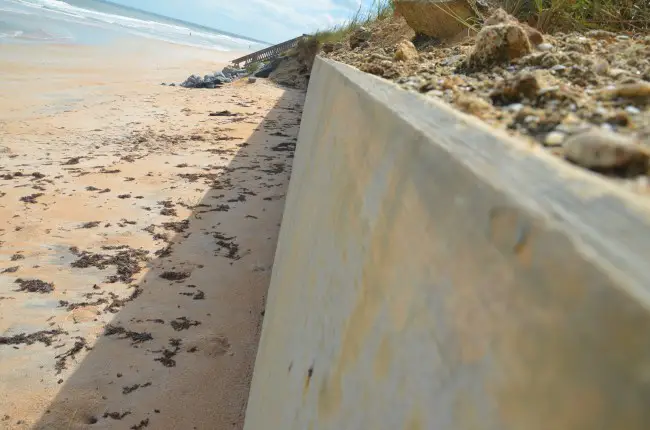
Flagler Beach and Flagler County may be heading toward a showdown over the fate of the eroding beach they have in common. Between now and then, the Flagler Beach City Commission itself may fracture on either side of an unresolved conflict between those opposed to protecting the beach by way of dredging up and dumping sand on it, and those willing to give that approach a shot despite its costs and uncertainties.
“While I don’t love the Army Corps and I don’t think they have a final answer about anything, if we don’t do this, we’re not going to do anything,” the city commission’s Jane Mealy said of a corps project that could cost close to $10 million to coat the city’s dunes and rock revetments in sand dredged up offshore.
Flagler Beach has been debating the best way to save its beach for years, if not decades, with little to show for it. The county is pushing the Army Corps approach, and is scheduled to unveil a feasibility study about that approach next month. The study alone will run $3.5 million. No one on the Flagler Beach Commission is thrilled either with the Corps or with dredging, but options are dwindling.
The city was willing to consider a novel approach proposed by a crusty, eccentric engineer called Dick Holmberg, whose “undercurrent stabilizers” would, in his projection, have naturally rebuilt the beach’s sands, but at a cost of $10 million. The city was willing enough to pay Holmberg $50,000—money secured through the county’s Tourist Development Council—for a so-called shoreline analysis as a first step toward making the project happen. But the analysis, in the city’s view, was too shoddy and too vague to work with.
“That document was not something that got us to the next level,” Flagler Beach mayor Linda Provencher said. “I wasn’t impressed by it, a lot of people were not impressed by it.”
“We asked him what comes next. He didn’t really answer it,” Mealy said. Earlier this month commissioners unanimously agreed to sever their ties with Holmberg, even as they paid him the last $5,000 due to cleanly end their relationship with him.
But that left the city without an alternative of its own to dredging. As the county was pushing that project forward, Commissioner Kim Carney, who’d championed Holmberg but was also dissatisfied with his work, took her colleagues by surprise with a proposal to explicitly reject the Army Corps approach—and did so at the same meeting that ended the Holmberg relationship.

Dredging, Carney said, saves nothing, because there aren’t enough structures to save: communities that have issues have built too close to the sea. In Flagler Beach, it’s protecting only State Road A1A—if it even protects it. “All they’re doing is covering the revetment which is not going to lead to stopping the erosion,” Carney continued, eliciting disagreement from some of her fellow-commissioners. “The sand is going to cover the entire dune system, which belongs to FDOT”—the Florida Department of Transportation—“which should be an FDOT project. Why should the citizens of Flagler County pay for the feasibility study, pay for the project, and it’s all government areas. I showed you where the whole stretch of that area belongs. It’s in the right of way for FDOT. It’s not our land.” She added: “This is nothing more than saving A1A. The revetment is going to save A1A. The seawall is going to save A1A. The sand is just going to beautify it. When it hits, it’s just going to hit. It’s not going to save A1A. It’s not our citizens’ responsibility to save A1A with dredged sand.”
Carney got support from Provencher: “Probably political suicide for me too, but I’d love to tell them to stick it.” And she even got guarded support from commissioners Steve Settle, but not to go ahead with the resolution. At least not yet.
“I agree with almost everything you said,” Settle said. “I do have one problem though, and that’s timing. We’ve been trying to cooperate with the county.” Settle proposed withdrawing the resolution until after the Army Corps’ feasibility study was published, and meanwhile pressure the county to include Flagler Beach at the table.
Carney agreed, rendering moot—for now—a stern letter County Administrator Craig Coffey had written the commission (and asked it to read it into its record) opposing Carney’s proposal. “When someone asks whether the Army Corps can do what we intend to accomplish, the answer is likely yes,” Coffey wrote, “depending on how you define ‘we’ and ‘success.’ If success means you have to make some investments in your shoreline on an ongoing basis in an environmental manner in order to retain A1A and to protect your beach and shoreline then the Corps probably would have had plenty of success.”
He pointed to an ongoing Corps project in St. Johns, and continued, his hectoring tone unveiled: “Are we so different or special? No. Is it perfect? No. Is it cheap? No. Is it forever? No, nothing is. At the end of the day, the ocean is going to do what it’s going to do, man can only try, nothing is guaranteed in these types of projects.” But the Corps, the administrator said, intends to protect the beach without adding to a seawall and by covering unseemly rock revetments. “With this type of project most people would call that a success, even if the dunes have to be repaired and replanted once a decade.”
While several people who addressed the city commission at its meeting earlier this month also opposed the Corps and dredging, one reflected the quandary it finds itself in: merely opposing dredging is not a solution, anymore than merely opposing seawalls or opposing Holmberg’s proposal may be a solution.
“If you want consensus that we’re just going to let nature take its course, I’m fine with that, but don’t just say no and expect them to come back with something else,” the resident said. “I think that’s what you ought to be voting on. Don’t go in there and be wishy-washy. Say we don’t want anything.”
That, Carney said, is what her resolution would have achieved. But if Flagler Beach takes that course, it would also be choosing to be little more than a Commission of No. Clearly, several commissioners are not ready to be that political version of a seawall against Flagler County, or the Corps.




























Jan Reeger says
One of the worst possible decisions would be to pay $3.5 million for a “study”. What engineer or consulting firm would laugh all the way to the bank on that one?
Apparently, there are no good solutions. I agree with looking at the east coast from Florida and even further north to see what is being done. Then, make a decision to do something.
Deep South says
Every town and tax payer in Flagler County needs to contribute to saving our beaches. I say if you use the beach you need to pay your share, just like the roads and parks.
MSFB says
Why not learn from one of the best, Mother Nature. An artificial reef could be built the same as our fishing reefs parallel to to the beach. Ocean swells and storm surf would break on the reef making it so that only a ripple reaches the beach. Most islands are protected this way with outer reefs built naturally by Mother Nature. The reefs could be built 100 to 200 yards off shore, fishing would be improved and the space between the beach and reef will become shallow with sand filling in.
Richard Schaefer says
Flagler Beach A1A Highway Erosion
As I see it, the purpose of the studies was to maintain and preserve the A1A road. That means the Florida Department of Transportation(FDOT) is responsible and should bear the burden of keeping the road open. Flagler Beach should not be involved in this decision and they wasted $50,000 on a study that ultimately was rejected.
Many years ago when I was growing up on Long Island, NY we had a similar problem where houses were being undermined and beginning to fall into the water. The solution was to build jetties straight out into the water perpendicular to the shoreline. They extended out about 100′ and were spaced approximately 100 yards apart and consisted of large boulders that were brought in by barge by the Army Corps of Engineers.
The erosion stopped and then the beach began to build up with deposited sand. It continued to build up to the end of the jetties and after about ten years, the boulders were no longer visible. That was in the mid-1950’s and to this day, it has been proven to be a long-term solution to the problem.
CONCLUSION: The FDOT needs to negotiate directly with the Army Corp to get this done because the right-of-way does not belong to the City of Flagler Beach.
Richard Schaefer